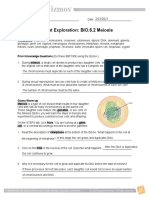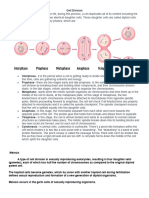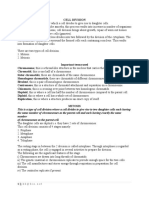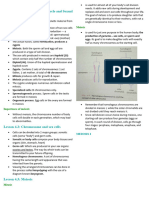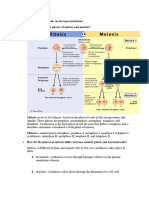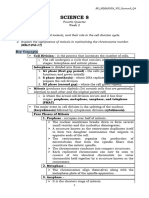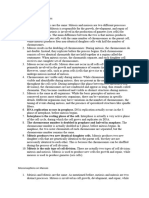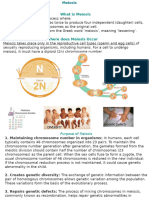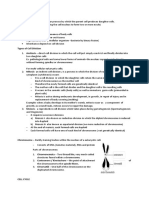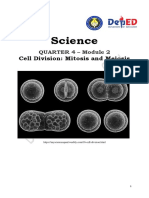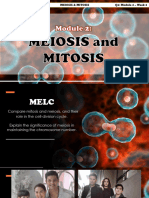0 ratings0% found this document useful (0 votes)
3 viewsCellular Reproduction
Cellular Reproduction
Uploaded by
nathalygiateresaCopyright:
© All Rights Reserved
Available Formats
Download as DOCX, PDF, TXT or read online from Scribd
Cellular Reproduction
Cellular Reproduction
Uploaded by
nathalygiateresa0 ratings0% found this document useful (0 votes)
3 views2 pagesOriginal Title
Cellular-reproduction
Copyright
© © All Rights Reserved
Available Formats
DOCX, PDF, TXT or read online from Scribd
Share this document
Did you find this document useful?
Is this content inappropriate?
Copyright:
© All Rights Reserved
Available Formats
Download as DOCX, PDF, TXT or read online from Scribd
Download as docx, pdf, or txt
0 ratings0% found this document useful (0 votes)
3 views2 pagesCellular Reproduction
Cellular Reproduction
Uploaded by
nathalygiateresaCopyright:
© All Rights Reserved
Available Formats
Download as DOCX, PDF, TXT or read online from Scribd
Download as docx, pdf, or txt
You are on page 1of 2
Cellular reproduction is the process by which cells 4.
Telophase: Chromatids reach the poles and
divide and produce new cells. This process is essential begin to de-condense into chromatin. The
for growth, repair, and maintenance of tissues in nuclear envelope re-forms around each set of
multicellular organisms, as well as for reproduction in chromosomes, resulting in two nuclei in the cell.
unicellular organisms. Cellular reproduction can be
5. Cytokinesis: This is the final step, where the
broadly categorized into mitosis and meiosis.
cytoplasm of the cell divides, resulting in two
1. Mitosis separate daughter cells. In animal cells, this
occurs through cleavage furrow formation, while
Mitosis is the process by which a eukaryotic cell
in plant cells, a cell plate forms to divide the
divides to produce two genetically identical daughter
cell.
cells, each with the same number of chromosomes as
the original cell. Mitosis is responsible for growth, 2. Meiosis
repair, and asexual reproduction in many organisms.
Meiosis is a type of cell division that reduces the
Stages of Mitosis: chromosome number by half, resulting in four
genetically diverse daughter cells, each with half the
1. Prophase: Chromosomes condense and
number of chromosomes as the original cell. Meiosis is
become visible. The nuclear envelope breaks
essential for sexual reproduction and occurs in two
down, and the mitotic spindle, made of
stages: meiosis I and meiosis II.
microtubules, begins to form.
Stages of Meiosis:
2. Metaphase: Chromosomes align at the cell's
equatorial plane (metaphase plate), and spindle Meiosis I:
fibers attach to the centromeres of the
1. Prophase I: Chromosomes condense, and
chromosomes.
homologous chromosomes (one from each
3. Anaphase: Sister chromatids (duplicated parent) pair up in a process called synapsis.
chromosomes) are pulled apart toward opposite Crossing over occurs, where segments of
poles of the cell. chromatids are exchanged between homologous
chromosomes, increasing genetic diversity. The
nuclear envelope breaks down, and spindle Summary
fibers form.
Mitosis: Produces two genetically identical
2. Metaphase I: Homologous chromosome pairs diploid cells, important for growth, repair, and
align at the metaphase plate. Spindle fibers asexual reproduction.
attach to each chromosome pair.
Meiosis: Produces four genetically diverse
3. Anaphase I: Homologous chromosomes are haploid cells, essential for sexual reproduction
pulled apart to opposite poles of the cell. Unlike and genetic diversity.
mitosis, sister chromatids remain attached.
Both processes are vital for the continuity of life and
4. Telophase I: Chromosomes reach the poles, the maintenance of genetic integrity within organisms.
and the nuclear envelope may reform. The cell
divides into two haploid cells.
Meiosis II:
1. Prophase II: Chromosomes condense again,
and a new spindle apparatus forms in each
haploid cell. The nuclear envelope breaks down.
2. Metaphase II: Chromosomes align at the
metaphase plate in each haploid cell.
3. Anaphase II: Sister chromatids are separated
and pulled toward opposite poles.
4. Telophase II: Chromatids reach the poles, and
nuclear envelopes reform around each set of
chromosomes. The cells divide, resulting in four
haploid daughter cells.
You might also like
- Grade 12 Life Sciences Book Please Share To Others - 041647Document113 pagesGrade 12 Life Sciences Book Please Share To Others - 041647mathebulawitness3100% (1)
- Gizmo (Meiosis)Document8 pagesGizmo (Meiosis)Elijah63% (8)
- Mitosis Worksheet: Prophase Metaphase InterphaseDocument3 pagesMitosis Worksheet: Prophase Metaphase InterphaseChristopher John Sumilang100% (2)
- Grade 11 Biology Exam ReviewDocument16 pagesGrade 11 Biology Exam ReviewPavni ChandaniNo ratings yet
- Edexcel Biology As Core Practical WorkbookDocument62 pagesEdexcel Biology As Core Practical WorkbookTim Filtness91% (33)
- Group H Pathology PresentationDocument15 pagesGroup H Pathology PresentationdorsukendraNo ratings yet
- Mitosis and MeiosisDocument8 pagesMitosis and MeiosisShiela BelandresNo ratings yet
- BiologyDocument2 pagesBiologywaniyaabbasi18No ratings yet
- TEXT READINGS Chapter - 16Document6 pagesTEXT READINGS Chapter - 16tanusehdev17No ratings yet
- Cell DivisionDocument5 pagesCell DivisionEloisa MadrilenoNo ratings yet
- Cell DivisionDocument2 pagesCell Divisionrobertsontrent25No ratings yet
- Cell DivisionDocument5 pagesCell DivisionSsonko EdrineNo ratings yet
- Cell DivisionDocument8 pagesCell Divisionlelejfintlskia1we39No ratings yet
- 2nd MT Biology ReviewerDocument4 pages2nd MT Biology ReviewerAliah HernandezNo ratings yet
- Mitosis Vs MeiosisDocument7 pagesMitosis Vs MeiosisJD DX100% (1)
- Pre-Lab - Mitosis and MeiosisDocument12 pagesPre-Lab - Mitosis and MeiosisMaria Jose MartinezNo ratings yet
- Cell DivisionDocument8 pagesCell DivisionNusrat ShoshiNo ratings yet
- Introduction To Cell ReproductionDocument32 pagesIntroduction To Cell ReproductionAntolyn DediosNo ratings yet
- Growth in CellsDocument7 pagesGrowth in Cellschideraangelg5fNo ratings yet
- Science8WS Q4 Week2Document11 pagesScience8WS Q4 Week2Desiree Tuares LotasNo ratings yet
- Class 10 Biology Chapter 2 Revision Notes GeneticsDocument3 pagesClass 10 Biology Chapter 2 Revision Notes GeneticsLakkiNo ratings yet
- Cell DivisionDocument4 pagesCell DivisionricafortmoriahazNo ratings yet
- Cell DivisionDocument3 pagesCell DivisionFans TimeNo ratings yet
- Cell Division o-WPS OfficeDocument2 pagesCell Division o-WPS OfficeRusselleen MalimbogNo ratings yet
- F3 2021 Reproduction in PlantsDocument27 pagesF3 2021 Reproduction in PlantslastyngugiNo ratings yet
- MitosisDocument3 pagesMitosisdiegocmakoNo ratings yet
- Mitosis and MeiosisDocument4 pagesMitosis and MeiosisMicah Porcal ArelladoNo ratings yet
- BIO 110 the cell cycle mit & meiDocument8 pagesBIO 110 the cell cycle mit & meielijahsiwale644No ratings yet
- 4 MeiosisDocument14 pages4 MeiosisMary Joy ReyesNo ratings yet
- CellsDocument1 pageCellsyanabantilanNo ratings yet
- Cell Structure and Cell DivisionDocument70 pagesCell Structure and Cell DivisionAMALIA INDAH ALLIZA ALLIZANo ratings yet
- Sci8 Q4 Wk2 Cell-Division BagaoisanDocument15 pagesSci8 Q4 Wk2 Cell-Division BagaoisanjannahcabotajeNo ratings yet
- Cell DivisionDocument1 pageCell DivisionManas AgrawalNo ratings yet
- Mitosis & MeiosisDocument28 pagesMitosis & MeiosisEma ColleteNo ratings yet
- Meiosis - Clay ModellingDocument4 pagesMeiosis - Clay ModellingAlexandra M.No ratings yet
- Cell Cycle-INTERPHASE-CELL DIVISIONDocument57 pagesCell Cycle-INTERPHASE-CELL DIVISIONcabilesrobilyn479No ratings yet
- Cell DivisionDocument27 pagesCell DivisionLavinia DonaldNo ratings yet
- Cell-Division-NotesDocument6 pagesCell-Division-NotesChristian Love EstorqueNo ratings yet
- Reviewer Gr12 Mitosismeiosis.Document3 pagesReviewer Gr12 Mitosismeiosis.Pinky SalesNo ratings yet
- Misconceptions On Mitosis and MeiosisDocument2 pagesMisconceptions On Mitosis and MeiosisEdcademiaNo ratings yet
- CELL DIVISION-MitosisDocument28 pagesCELL DIVISION-MitosisAVINASH VARMANo ratings yet
- Meiosis Phases After Sexual ReproductionDocument30 pagesMeiosis Phases After Sexual ReproductionJohanna UrwinNo ratings yet
- Biology Mitosis Notes (O Level)Document9 pagesBiology Mitosis Notes (O Level)ojilong100% (1)
- Cell DivisionDocument5 pagesCell DivisionLief LifeNo ratings yet
- MF009 4B Nuclear Division James L2Document29 pagesMF009 4B Nuclear Division James L2PikuNo ratings yet
- Cell Cycle and Cell Division Class 11 Notes. " (Cbse)Document8 pagesCell Cycle and Cell Division Class 11 Notes. " (Cbse)madam photonNo ratings yet
- Meiosis and MitosisDocument6 pagesMeiosis and MitosisSummer LoveNo ratings yet
- Science8 Q4 M2Document6 pagesScience8 Q4 M2Arabella BaldonadoNo ratings yet
- Biology CH # 5 To 9 NoteDocument83 pagesBiology CH # 5 To 9 Notefurqanshaikh2334No ratings yet
- Mitosis and Meiosis ExamDocument6 pagesMitosis and Meiosis ExamAishley BerdinNo ratings yet
- MitosismeiosisDocument44 pagesMitosismeiosisalanamaharaj20No ratings yet
- BIOLOGY Worksheet 4.2 Mitosis Vs MeiosisDocument6 pagesBIOLOGY Worksheet 4.2 Mitosis Vs MeiosisEvcha WangagNo ratings yet
- Mitosis and MeiosisDocument6 pagesMitosis and MeiosisunadynamicNo ratings yet
- Summary Prac 5Document2 pagesSummary Prac 5phuonghuynh3097No ratings yet
- Module 2 Meiosis and MitosisDocument88 pagesModule 2 Meiosis and MitosisSevdred CadelinaNo ratings yet
- MeiosisDocument3 pagesMeiosisJaja Jr. Evasco EmbarqueNo ratings yet
- Differences Between Mitosis and MeiosisDocument79 pagesDifferences Between Mitosis and Meiosismaxwell amponsahNo ratings yet
- Unit -5 Part 2 Bio 9th - Notes - NewDocument4 pagesUnit -5 Part 2 Bio 9th - Notes - Newwxyz23101504No ratings yet
- SEC 10 (Cell and Molecular Biology) - Final RequirementDocument15 pagesSEC 10 (Cell and Molecular Biology) - Final RequirementANGEL MAE LORBESNo ratings yet
- What Happens When Food Reaches The StomachDocument9 pagesWhat Happens When Food Reaches The StomachAvegail MantesNo ratings yet
- Mitosis V MeiosisDocument5 pagesMitosis V MeiosisddaarrsshhiittNo ratings yet
- Cell Cycle and Cell DivisionDocument6 pagesCell Cycle and Cell DivisionJeyanthiNo ratings yet
- BIO T4 KSSM Chapter 6 - DLPDocument62 pagesBIO T4 KSSM Chapter 6 - DLPcikguana79No ratings yet
- Early March, Meiosis - Mitosis Study Guide (3.3)Document9 pagesEarly March, Meiosis - Mitosis Study Guide (3.3)ChanelleNo ratings yet
- Ans Chapter 6 Cell DivisionDocument22 pagesAns Chapter 6 Cell Division汪楷熙No ratings yet
- Cell Division For Grade 8Document8 pagesCell Division For Grade 8Janella RedrinoNo ratings yet
- Fish Genetics Theory and Practice PDF FormatDocument194 pagesFish Genetics Theory and Practice PDF FormatMohina DasguptaNo ratings yet
- Module in EnglishDocument28 pagesModule in EnglishIannNo ratings yet
- Science 8 q4 2nd Mod.Document17 pagesScience 8 q4 2nd Mod.Micole BrodethNo ratings yet
- Zoology Notes: 006 Chapter 3Document7 pagesZoology Notes: 006 Chapter 3humanupgrade100% (1)
- IBDP Biology Revision Guide (SL) - Knowledge and ApplicationDocument43 pagesIBDP Biology Revision Guide (SL) - Knowledge and Application[5L14] Cheung Samara Nathania100% (1)
- CLASS X - ICSE Biology Project 2024-2025Document27 pagesCLASS X - ICSE Biology Project 2024-2025elobo3005No ratings yet
- 1st Sem QuestionsDocument34 pages1st Sem Questionsazizirabia5No ratings yet
- C5.2 Mitosis + Cytokinesis Study GuideDocument2 pagesC5.2 Mitosis + Cytokinesis Study GuideEver Moises Carrillo LopezNo ratings yet
- Modeling Mitosis ActivityDocument3 pagesModeling Mitosis ActivityJobanie AmadhayNo ratings yet
- Cell Cycle Cell Division PDFDocument13 pagesCell Cycle Cell Division PDFmuzamil shabir100% (1)
- Open Genetics PDFDocument513 pagesOpen Genetics PDFSagenx100% (1)
- G8 Science Q4 - Week 2 - MeiosisDocument21 pagesG8 Science Q4 - Week 2 - MeiosisLeyannNo ratings yet
- 9700 s06 QP 1Document16 pages9700 s06 QP 1ClairDeLune123No ratings yet
- Cell Cycle and Cell DivisionDocument3 pagesCell Cycle and Cell DivisionKent Justine BarrogaNo ratings yet
- Biology Practicals STD-XII 24-25Document16 pagesBiology Practicals STD-XII 24-25indrakshi398No ratings yet
- ICSE Biology 10 - MCQs Term 1.pdf (Unknown)Document16 pagesICSE Biology 10 - MCQs Term 1.pdf (Unknown)Ishita SinghNo ratings yet
- Biotech 3 Cell DivisionDocument4 pagesBiotech 3 Cell DivisionClinton YmbongNo ratings yet
- Elmer J Sabalilag Stem 1: Mitosis MeiosisDocument1 pageElmer J Sabalilag Stem 1: Mitosis MeiosisAria NichiNo ratings yet
- Bs172 PWR PointDocument479 pagesBs172 PWR PointMickmush MwanzaNo ratings yet
- 1.6 MitosisDocument44 pages1.6 MitosisOmar ogiNo ratings yet
- EMBRYOLOGY Part1Document90 pagesEMBRYOLOGY Part1Daly DaliaNo ratings yet
- Teas Exam 2020Document87 pagesTeas Exam 2020Joy postrano100% (5)

